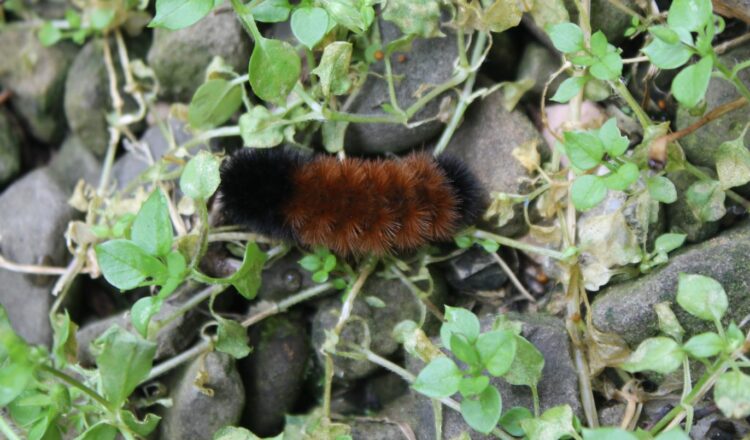By Bob Confer
The woolly bear is a well-known caterpillar, one that is especially noticeable in October and November when you will see many of them crawling across roads, driveways, sidewalks, and other warm surfaces.
When doing so, they are trying to find the warmest place to hibernate. Whereas many species of moths will overwinter as pupae in cocoons, most wooly bears do not. Instead, they curl up and freeze solid, become unthawed and lively again in the spring when they go about building cocoons. During the winter months, you might find them under items in or around your garage or the foundation of your home where they glean as much warmth and protection from predators as they can.
If there are two broods in a year, some caterpillars that were born early in the summer will spend the winter as pupae in small, light-brown cocoons made of their hairs. Those cocoons will blossom into the Isabella moth, which is a rather plain-looking yellow or cream colored moth about an inch and a half long.
The woolly bear caterpillar’s tell-tale banded appearance, which has black hairs at its ends and a wide reddish-brown band in the center, has led to much speculation about its magical ability to predict the severity of the coming winter. It’s been said that the wider the red band and the smaller the black bands, the less severe the winter will be.
It’s a silly belief, as no animal has such powers. Nonetheless, a few scientists have tried to prove that woolly bears are good forecasters. The most famous of these studies was done by Dr. Curran of the American Museum of Natural History. He and his wife studied woolly bear band lengths for nine consecutive years beginning in 1948 and they predicted the severity of the winter as a cutesy article for the New York Herald Tribune.
In some of those years, when the red bands were large, the forecast looked pleasant and the winters that followed were mild. That led many to believe the myths and the woolly bear became the most recognizable caterpillar in the country.
So, did that study actually prove that woolly bears knew what was coming?
No. It was coincidence…and actually a reflection of the winter prior.
Numerous studies that followed showed that the middle band represented how old the caterpillar was and how close to building a cocoon it might be. If the previous winter was mild, the first brood of young hatched earlier in the year, so, come the fall, they were older and, in turn, their bands wider. So, the caterpillar’s coloration more likely indicated how mild or severe the previous winter was and not what the coming one will be like.
Despite the debunking, the stories around woolly bears still exist and serve as good, folksy fun. If you spend any amount of time outside in the fall, you will encounter numerous woolly bears. Take a moment to admire the cute insects and, just for kicks, see if they really do have the ability to forecast the weather.







